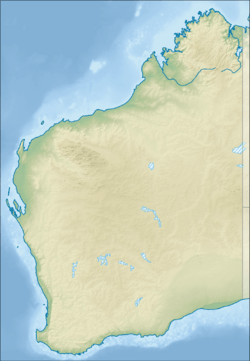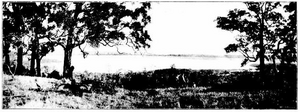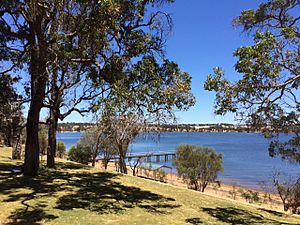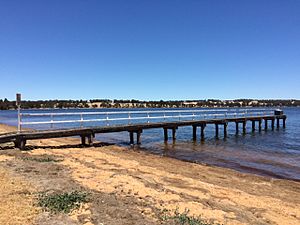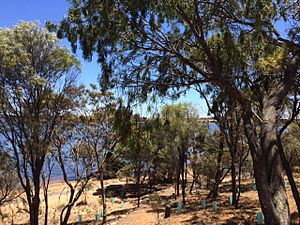Lake Towerrinning facts for kids
Quick facts for kids Lake Towerrinning |
|
|---|---|
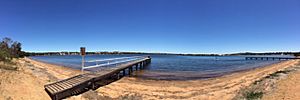
Lake Towerrinning in 2018
|
|
| Location | Wheatbelt, Western Australia |
| Coordinates | 33°34′56″S 116°46′59″E / 33.58222°S 116.78306°E |
| Type | brackish |
| Primary inflows | surface flow from north west |
| Primary outflows | surface flow to south east |
| Catchment area | 12,500 ha (31,000 acres) |
| Basin countries | Australia |
| Max. length | 1,650 m (5,410 ft) |
| Max. width | 1,350 m (4,430 ft) |
| Surface area | 180 ha (440 acres) |
| Average depth | 2.5 m (8 ft 2 in) |
| Shore length1 | 4,800 m (15,700 ft) |
| Surface elevation | 219 m (719 ft) |
| Islands | 0 |
| Settlements | none |
| 1 Shore length is not a well-defined measure. | |
Lake Towerrinning is a permanent lake in the Wheatbelt area of Western Australia. It is about 32 kilometers (20 miles) south of Darkan. The lake is also about 44 kilometers (27 miles) southwest of Wagin. It is located roughly 245 kilometers (152 miles) southeast of Perth.
The water in Lake Towerrinning is brackish, which means it is a mix of fresh and salty water. The Department of Parks and Wildlife looks after the lake. It is a popular spot for fun activities. The Shire of West Arthur also uses part of the lake for water skiing.
Contents
About Lake Towerrinning
This lake covers about 180 hectares (445 acres). Most of it is inside a 256-hectare (633-acre) nature reserve. This reserve is very important for wildlife. It is one of the few large, permanent water bodies that are quite fresh. This makes it a safe place for many animals.
Lake Towerrinning is part of a bigger area called the Towerrining Lake and Moodiarrup Swamps Important Bird Area. It is also part of the Arthur River Wetlands System. This system is found within the Blackwood basin.
The land that drains into the lake is called its catchment area. This area is about 6,000 hectares (14,826 acres). The lake gets about 550 millimeters (22 inches) of rain each year. However, about 1,873 millimeters (74 inches) of water evaporates each year. The lake is located where an old riverbed, called a paleochannel, might be.
Water flows into the lake from a swamp in the northwest. It then flows out through a swamp on the southern side. This water eventually reaches the Arthur River. The land around the lake has low hills and gentle slopes. It also has narrow valleys and wide flat areas. The soil is a mix of sandy, gravelly, and clay soils.
History of the Lake
The Noongar people are the traditional owners of this land. They have lived here for thousands of years. Lake Towerrinning and the land around it are very special to them. It was a place for corroborees (traditional gatherings). It was also a meeting and camping spot with good hunting grounds.
The first European to visit the lake was Thomas Bannister in 1832. He was exploring the area and called it a "rushy lagoon."
By 1909, farmers were quickly choosing land around the lake. They used it for growing crops or raising animals. In 1926, a property owned by T.V.Williams was next to the lake.
The last time Indigenous Australian people set up temporary camps here was in 1938. They were looking for food from the bush. In the 1940s, more land was cleared. This caused more water to run into the lake, making it bigger. But by the 1960s, the lake started to become salty.
A caravan park opened near the southern shore of the lake in 1982.
In 1989, a group called the Lake Towerrinning catchment landcare group was formed. Their goal was to make the water quality better. In 1993, they built a new system to help the lake. This system lets fresher water flow into the lake. It also helps to send salty water away from the lake.
Things to Do at the Lake
Lake Towerrinning has many things for visitors to enjoy. There are two jetties and a boat ramp. You can also find public toilets and change rooms. For kids, there is a playground. There are also barbeques, camping areas, and picnic spots.
You can go Water skiing on the lake from sunrise to sunset. However, you must stay at least 30 meters (98 feet) away from the shore. The only exceptions are in special areas for starting and ending your water skiing.
Wildlife at Lake Towerrinning
Flora (Plants)
Most of the land around the lake has been cleared for farming. The plants here are part of the Beaufort Vegetation System. You can find marri (Corymbia calophylla) and wandoo (Eucalyptus wandoo) trees on the rolling hills. In the valleys, swamp yate (Eucalyptus occidentalis) is more common.
Around the main part of the lake, you can see woodlands. These have wandoo, flooded gums (Eucalyptus rudis), rock sheoak (Allocasuarina huegeliana), acorn banksia (Banksia prionotes), and freshwater paper bark (Melaleuca rhaphiophylla). There are also saltwater paperbark (Melaleuca cuticularis), saltwater sheoak (Casuarina obesa), and different types of samphire. You might also find groups of marri trees. The only native water plant found here is Ruppia megacarpa.
Grasses and sedges growing around the lake include Baumea articulata, Baumea juncea, Lepidosperma longitudinale, Juncus kraussii, Juncus pallidus, Hordeum geniculatum, and Paspalum vaginatum.
Fauna (Animals)
The area around Lake Towerrinning is a very important home for many animals. It supports 14 types of frogs, 43 types of reptiles, 171 types of birds, and 23 types of mammals. It is a safe place for many birds, both those that live there all the time and those that migrate.
BirdLife Australia has named the lake an Important Bird Area. This is because it is home to a large number of blue-billed ducks. Other birds you might see include the Australasian bittern, black cockatoo, peregrine falcon, and the eastern great egret. Many types of reptiles also live around the lake. One example is the long-necked tortoise.


